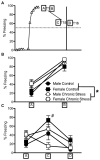Chronic stress and sex differences on the recall of fear conditioning and extinction
- PMID: 19073269
- PMCID: PMC2673234
- DOI: 10.1016/j.nlm.2008.11.005
Chronic stress and sex differences on the recall of fear conditioning and extinction
Abstract
Chronic stress effects and sex differences were examined on conditioned fear extinction. Male and female Sprague-Dawley rats were chronically stressed by restraint (6 h/d/21 d), conditioned to tone and footshock, followed by extinction after 1 h and 24 h delays. Chronic stress impaired the recall of fear extinction in males, as evidenced by high freezing to tone after the 24 h delay despite exposure to the previous 1 h delay extinction trials, and this effect was not due to ceiling effects from overtraining during conditioning. In contrast, chronic stress attenuated the recall of fear conditioning acquisition in females, regardless of exposure to the 1 h extinction exposure. Since freezing to tone was reinstated following unsignalled footshocks, the deficit in the stressed rats reflected impaired recall rather than impaired consolidation. Sex differences in fear conditioning and extinction were observed in nonstressed controls as well, with control females resisting extinction to tone. Analysis of contextual freezing showed that all groups (control, stress, male, female) increased freezing immediately after the first tone extinction trial, demonstrating contextual discrimination. These findings show that chronic stress and sex interact to influence fear conditioning, with chronic stress impairing the recall of delayed fear extinction in males to implicate the medial prefrontal cortex, disrupting the recall of the fear conditioning acquisition in females to implicate the amygdala, and nonstressed controls exhibiting sex differences in fear conditioning and extinction, which may involve the amygdala and/or corticosterone levels.
Figures



References
-
- Anisman H, Matheson K. Stress, depression, and anhedonia: Caveats concerning animal models. Neuroscience and Biobehavioral Reviews. 2005;29:525–546. - PubMed
-
- Atkinson HC, Waddell BJ. Circadian variation in basal plasma corticosterone and adrenocorticotropin in the rat: sexual dimorphism and changes across the estrous cycle. Endocrinology. 1997;138:3842–3848. - PubMed
-
- Báez M, Siriczman I, Volosin M. Corticosterone is involved in foot shock-induced inactivity in rats. Physiology & Behavior. 1996;60:795–801. - PubMed
-
- Baran SE, Wright RL, Jackson JL, Kleen JK, Tsekhanov S, Wise L, Zachow KA, Conrad CD. Ovariectomized female rats demonstrate enhanced spatial memory on the Y-maze following chronic stress while acute estrogen treatment may attenuate performance. Society for Neuroscience Abstracts. 2002;28:370.312.
Publication types
MeSH terms
Grants and funding
LinkOut - more resources
Full Text Sources
Medical

